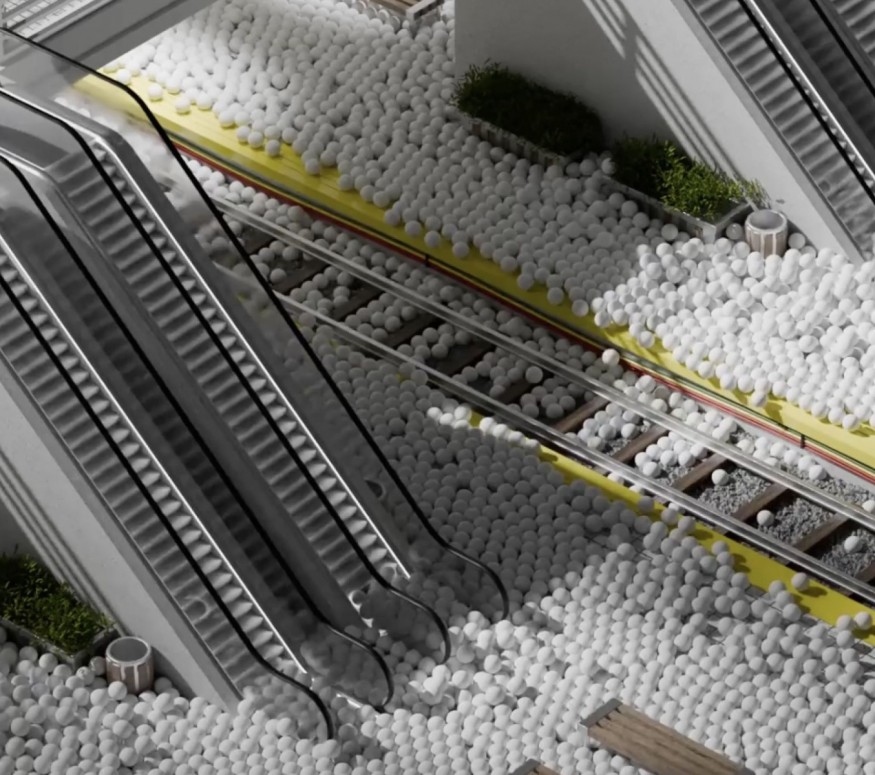3D Animator Nicky Kolk’s Dazzling Simulation ‘Did I Add Enough Balls?’ Transforms Blender Into a Digital Spectacle

In digital artistry, innovation knows no bounds, and 3D Animator Nicky Kolk, the Founder of AndesAnimations, recently left audiences in awe with his breathtaking creation titled "Did I add enough balls?" The project, a mesmerizing 3D simulation, unfolds as a cascade of countless white balls spills from train cars, transforming a digital metro station into a sea of motion and spectacle. Executed in Blender, this project showcases not only Kolk's creative prowess but also the advanced capabilities of 3D animation technology.
The Creation Process
At the heart of this captivating simulation lies a meticulous and intricate process executed by Kolk. The project, designed as a rigid body simulation in Blender, represents a specific type of simulation engineered to emulate the movement of solid objects. This choice enabled Kolk to bring a stunningly realistic quality to the motion and interaction of the myriad white balls in the digital environment.
From inception to completion, the project demanded an impressive 20 hours of dedicated work. This time investment underscores the meticulous attention to detail required in 3D animation, where every frame contributes to the final visual impact—notably, a significant portion of this time-12 hours is allocated to the rendering process alone.
Rendering the Art of Bringing Dreams to Life
Rendering, an essential aspect of 3D animation, involves transforming a raw digital model into the final, visually striking image or sequence that audiences witness. In the case of "Did I add enough balls?" the rendering process consumed a substantial portion of the project's timeline. Kolk dedicated 12 hours to ensuring that every frame of the simulation met the standards of excellence he envisioned.
The painstaking rendering process is a testament to the commitment and passion that animators like Kolk pour into their creations. During this phase, the digital realm comes to life, as each frame is meticulously polished to capture the essence of movement and realism. The intricate dance of light and shadow, texture subtleties, and objects' nuanced interplay are all meticulously refined during the rendering phase.
While the result of "Did I add enough balls?" is undoubtedly a visual feast, the journey to its creation was not without its challenges. 3D animation requires a delicate balance between creativity and technical proficiency, particularly when dealing with complex simulations like this one. Kolk navigated the intricacies of Blender, overcoming obstacles to bring his vision to fruition.
One of the notable challenges in such simulations is achieving a seamless and natural flow of movement. The artist must meticulously adjust parameters, ensuring that each ball interacts authentically with its surroundings, emulating the physics of the real world. Achieving this level of realism in a digital space demands expertise and a keen eye for detail.
Beyond the challenges, "Did I add enough balls?" is a testament to the triumphs of innovation and dedication in 3D animation. It showcases the artist's capabilities and the limitless potential of tools like Blender in the hands of skilled creators.
The Impact and Reception
Upon unveiling his creation, Nicky Kolk captivated thousands with the sheer spectacle of "Did I add enough balls?" The digital metro station transformed into a canvas of movement and rhythm, captivating viewers and sparking conversations within the digital art community. Social media platforms buzzed with admiration as the simulation garnered praise for its creativity, technical execution, and sheer visual splendor.
The project's impact goes beyond its immediate visual appeal. It inspires aspiring 3D animators, demonstrating what is achievable with dedication, creativity, and a mastery of the tools. Kolk's work encourages others to push the boundaries of their craft, exploring the uncharted territories of digital animation.
In the ever-evolving landscape of digital artistry, Nicky Kolk's "Did I add enough balls?" stands as a beacon of creativity and technical excellence. The project's journey from concept to completion, the challenges surmounted, and the dedication poured into each frame highlight the intricate dance between art and technology in 3D animation.
As technology advances, we can anticipate even more awe-inspiring creations from talented animators who push the boundaries of what is possible. Kolk's work serves as a reminder that within the digital realm, imagination knows no bounds, and with the right tools and expertise, artists can turn dreams into visually stunning realities. "Did I add enough balls?" is not merely a simulation; it's a testament to the limitless potential of 3D animation as an art form.
Related Article : Bridge Studio Collective Transforms Vacant SoMa Building Into Art Haven, Revitalizing San Francisco's Creative Spirit
From Digital Models to 3D-Printed Homes: Jaspreet Kaur Lall Explains How the Innovation Changes the Construction Industry

Future Belongs to Green Construction: Sampath Kumar Paspunoori Explains One of the Key Trends in the Construction Industry

Kamala Harris' Campaign Ad Uses Iconic Visuals from Carrie Mae Weems to Connect with Voters

Historic Ancient Roman Ruins in Baalbek Remain Strong After Israeli Air Strikes; Locals Seek Cultural Protection

4 Ways to Honor Departed Loved Ones in Your Home Design













